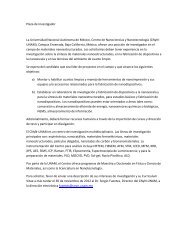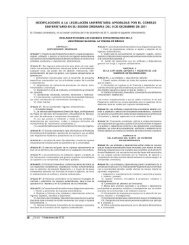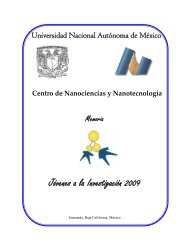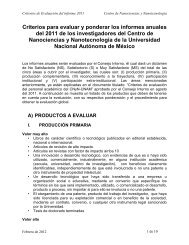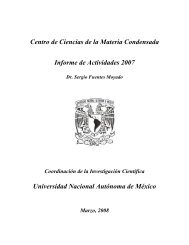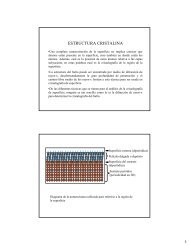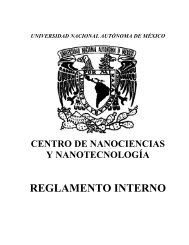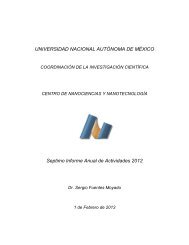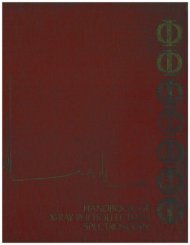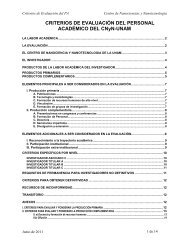Ep =3 keV - CNyN
Ep =3 keV - CNyN
Ep =3 keV - CNyN
- No tags were found...
You also want an ePaper? Increase the reach of your titles
YUMPU automatically turns print PDFs into web optimized ePapers that Google loves.
HANDBOOK OFAUGER ELECTRON SPECTROSCOPY
HANDBOOK OFAUGER ELECTRONSPECTROSCOPYA Reference Book of StandardData for Identification andInterpretation of Auger ElectronSpectroscopy DataSECOND EDITIONBylawrence E. DavisNoel C. MacDonaldPaul W. PalmbergGerald E. RiachRoland E. WeberPublished byPhysical Electronics DivisionPerkin·Elmer Corporation6509 Flying Cloud DriveEden Prairie. Minnesota 55343
Preface to the Second EditionSince the first edition of the HANDBOOK OFAUGER ELECTRON SPECTROSCOPY was publishedin 1972, the Auger Electron Spectroscopy(AESI technique has undergone considerabledevelopment. Higher excitation beam energies havebecome common and smaller beam sizes couptedwith beam scanning now enable elemental imagesto be routinely obtained. In addition, considerablework on the quantitative aspects of AES has beendocumented. The interest in the latter and theneed for more complete relative sensitivity data asa function of the various excitation and detectionparameters have spurred the ;lublication of theSecond Edition.The primary difference between the first and secondeditions lies in the completeness of the quantitativeinformation contained herein. A systematicdiscussion of the dependence of the quantitativedata in the Auger spectrum upon a number ofvariable parameters is now included.Descriptions and examples of how to use the datain the Handbook have been made more completeand spectra produced using higher energy electronbeam excitation have been added. A graphical presentationof relative elemental sensitivity factorsis now included. Spectra of several compounds,primarily oxides, have been added to illustratetypical changes in the spectra with variation inchemical matrix.We hope that this Second Edition of the Handbookof Auger Electron Spectroscopy will receive theacceptance, application and constructive criticismreceived by the First Edition.Physical Electronics Industries, Inc.February, 1976
I. AUGER ELECTRONSPECTROSCOPY
1. IntroductionThe Auger electron spectroscopy technique forchemical analysis of surfaces is based on the Augerradiationless process. When a core level of a surfaceatom is ionized by an impinging electronbeam, the atom may decay to a lower energy statethrough an electronic rearrangement which leavesthe atom in a doubly ionized state. The energydifference between these two states is given to theejected Auger electron which will have a kineticenergy characteristic of the parent atom. When theAuger transitions occur within a few angstroms ofthe surface, the Auger electrons may be ejectedfrom the surface without loss of energy and giverise to peaks in the secondary electron energydistribution function. The energy and shape ofthese Auger features can be used to unambiguouslyidentify the composition of the solid surface.An Auger electron spectroscopy system consists ofan ultrahigh vacuum system, an electron gun forspecimen excitation, and an energy analyzer fordetection of Auger electron peaks in the totalsecondary electron energy distribution. Because theAuger peaks are superimposed on a rather largecontinuous background, they are more easily detectedby differentiating the energy distributionfunction NIEI. Thus the conventional Auger spectrumis the function d~~EI . Electronic differentiationis readily accomplished with a velocity analyzerby superimposing a small a.c. voltage on the energyselecting voltage and synchronously detecting theoutput of the electron multiplier. The peak-topeakmagnitude of an Auger peak in a differentiatedspectrum generally is directly related to the surfaceconcentration of the element which producesthe Auger electrons. Quantitative analysis may beaccomplished with varying degrees of accuracy bycomparing the peak heights obtained from an unknownspecimen with those from pure elementalstandards or from compounds of known composi·tion.The sensitivity of the Auger technique is determinedby the transition probability of the Augertransitions involved, the incident beam current andenergy, and by the collection efficiency of theanalyzer. With a 3 kV, 50 p.A beam and a highsensitivity cylindrical mirror analyzer, the limit ofdetection for the elements varies between approxi·mately 0.02 and 0.2 atomic percent with spectrumscanning rates of 1 eV per second. All elementsabove helium produce Auger peaks in the 0-2000eVrange.PHYSICAL ELECTRONICS INOUSTRIES
2. Experimental Techniques Used toObtain Standard Auger SpectraThe experimental arrangement for obtaining theAuger spectra is shown in Figure 1. Several specimenswere mounted on the carrousel holder ateach loading and sequentially rotated into theanalysis position. The analysis was carried out withthe excitation beam normal to the specimen surfaceexcept for some nonconducting specimens wheregrazing incidence was required to reduce chargingeffects. In these cases the angle of incidence was60° for both the specimen and the silver standardused to set the operating parameters._.-._.._.~r;l_._.._..IE I'------,/' ,,~(..,-- I:::""r~=" .~~...-• ... .."..nb"-'----'..f \ . .~_\._'"".,,,.......Figure 1: SchematIc of the experimental arrangementused for obtaining standard Auger spectra.The procedures used to Obtain clean specimenswere argon ion sputter·etching, scribing, and thinfilm deposition. Most spectra were taken duringargon ion sputtering which produced relativelyclean surfaces without baking the system. Thesputter·etching rates were considerably faster thanthe adsorption rate of active residual gases.For many of the highly reactive metals the surfaceoxide layer was too thick for convenient removal bysputter-etching. A more expedient method for producinga clean surface was to scribe the surfacein situ with a carbide tip. The top of the scratchedgroove was wide enough to allow the incident electronbeam to excite only the freshly exposed ma~teriaJ. Even with the high speed cylindrical analyzer,considerable adsorption sometimes occurredbefore completion of the measurement. The highvapor pressure of many of the reactive metals preventedattainment of ultrahigh vacuum throughbakeout. The spectrum from magnesium was obtainedfrom a freshly evaporated film, and thecesium and argon spectra were obtained by implantingCs and Ar Ions in a silicon wafer. Thexenon spectrum was obtained by implanting Xeions in a carbon specimen.The energy scale was calibrated by measuring theanalyzer voltage required to transmit elasticallyreflected primary electrons of known energy. Afterreflection from the target surface into the analyzer,the kinetic energy of the primary electron is:where Vp is the electron gun voltage, ¢f is the electrongun filament work function and ¢a is the work1112
function of the analyzer material. The analyzervoltage required to transmit the elastically reflectedelectrons is:where a is a constant determined by the geometryof the analyzer. The measured at is Vo/V p while theactual a is given by (2). Thus the percentage errordue to work functions in this procedure is:~a ¢a - ¢,=a eV p131The difference between the work functions of thestainless steel analyzer and the tungsten filament isexpected to be less than 1 eV. For a gun voltage of2,000 volts the percentage error caused by workfunctions is therefore less than 0.05%. The accuracyof the measured gun voltage was better than onevolt at 2,000 volts. Thus, for the energy range fromzero to 2,000 eV, the instrumentation accuracy ofthe data presented here is about 1 eV.The amplitude of the Auger signal is dependent onthe exciting beam energy and current, the transmissionand resolution of the analyzer, the amplitudeof the modulation voltage, the multiplier gain,and the sensitivity setting of the lock-in amplifier.For meaningful comparison of the spectra fromvarious elements, it is necessary to record thesevariables.The analyzer transmission and resolution were 10%and about 0.6% respectively for all data in thishandbook.Beam energies of 3 and 5 keY were used to obtainthe Auger spectra in this handbook. The appropriatevalue of excitation energy is indicated on eachspectrum. Beam current ranged from 2 }J.A to 50}J.A and was adjusted to provide convenient measurementconditions but was kept low enough toavoid specimen damage.The multiplier gain was kept at a constant value byadjusting the multiplier voltage to maintain a constantpeak·to·peak deflection for the 351 eV Agpeak when using standard values for all other parameters.The amplitude of the modulation voltage used dependedon the energy width of the Auger peaks.The instrumental contribution to the peak widthincreases linearly with energy in velocity analyzers.Thus for a resolution of 0.6% the instrumental contributionis 6 eV at 1,000 eV and 12 eV at 2,000eV. The amplitude of the perturbing voltage rangedfrom 2 eV at low energies up to 6 eV at highenergies. In all cases care was taken to insure thatthe peak shapes were not distorted by overmodulation.Within this limit the amplitude of the Augersignal is proportional to the modulation amplitude.After adjusting the multiplier voltage to achieve astandard signal from Ag, only the lock-in amplifiergain, modulation amplitude and incident beamenergy and current were adjusted to obtain spectrafrom other samples. The scale factors which labeleach of the spectra in this handbook represent theincrease in instrumental sensitivity relative to thatused to obtain the Ag spectrum with 3 keYexcitation.The procedure used to normalize the multipliergain does not properly account for the variation infirst stage gain with energy. The first stage isnormally at ground potential which means thatthe Auger electrons strike the first stage with theirPHYSICAL ELECTRONICS INDUSTRIES 3
3000z,~• w 2000~• ~~~~ZQ•~ 1000u w~wo 200 ~ ~ ~ 1~ 1~ 1400 1~ 1~ 2~ELECTRON ENERGY.eVFigure 2:Typical electron multiplier gain variation with electron energy.initial energy. The multiplier gain varies with energyaccording to Figure 2. The low gain at low energiesis desirable in that it supresses the large, low energysignal from the true secondary electrons. For electronswith more than 200 eV energy the gain isnearly constant. If the energy dependence of thefirst stage gain varies in time, a corresponding erroroccurs in the scale factor. Above 200 eV, however,this error must be small, because the first stagegain in this range is nearly independent of energy.3. Qualitative AnalysisThe identification of peaks in the Auger spectrumis accomplished most efficiently through the combineduse of a chart of Principal Auger ElectronEnergies and the standard spectra. The chart (tnsideBack Cover) gives the relationship betweenAuger electron energies and atomic number. For'simplicity only the principal Auger peaks are listedon the chart. The KLL, LMM and MNN Augertransitions produce observable peaks which allowidentification of all elements above helium by scanningthe 0-2,000 eV range. Although Auger peaksfrom different elements can sometimes overlap,4
complete obliteration of peaks from a trace impurityby more dominant species seldom occurs in practice.A useful procedure for labeling peaks in an Augerspectrum is the following:1. First concentrate only on the major peaks.Use the chart of Principal Auger ElectronEnergies to reduce the number of possibilitiesto two or three elements. The correct identificationof major Auger peaks is then easilyaccomplished by referring to the standardAuger spectra. When making this comparisonit must be noted that peak shifts of a feweVohen occur due to chemical bonding. Therefore,deviations of a few eV in peak energyfrom those listed on the standard spectrashould be considered insignificant if the elementin question is in a chemical environ"ment different from that used for the standardspectrum.2. When poSitIve identification of major constituentshas been made, use the standardspectra to label all peaks attributable to them.3. Peaks which are not yet labeled originate fromminor constituents whose identification proceedsas above. Because of low concentration,only the most prominent peaks of these elementswill be observed in the spectrum.In general, this procedure results in rapid and unambiguousinterpretation of the spectra. If peaksremain which have not yet been identified, theymay be energy loss peaks due to primary electronswhich have lost a discrete amount of energy throughionization of core levels. To test this possibility,change the primary beam energy and observewhether the peak shifts in energy by the sameamount. If the peak moves, it is not an Augerpeak. To minimize the occurrence of energy losspeaks, the primary beam energy should be set wellabove the Auger energies of interest.4. Quantitative AnalysisIn determining the relationship between the Augerelectron signal and atomic concentration it isnecessary to evaluate the effect of instrumentalparameters on the measured Auger signal. The importantinstrumentai variables are the primaryelectron beam current Up), the primary beamenergy (E p ) and, for the conventional dN(E)/dEspectrum, the modulation energy (Em)'The anticipated linear relationship between theAuger peak-to-peak amplitude and I p is experimentallyverified in Figure 3 for the Au (69 eV)peak. This linear relationship between Auger amplitudeand incident beam current is no longer validwhen the incident electron beam diameter exceedsthe analyzer source diameter or when excessivelyhigh current density causes damage to the specimen.PHYSICAL ELECTRONICS INDUSTRIES 5
Au (69 tV), 5 10 15 20BEAM CURRENT ~I,JlA25 lOFigure 3: Verification of the linear relationship between the peak-to-peak amplitude of the Auger signal and excitationbeam current for the Au(69 eV) Auger peak; <strong>Ep</strong> '" 5 <strong>keV</strong>, Em '" 2 eV.The relationship between the Auger peak-to-peakamplitudes of the Au (69 eV) and Au (2024 eV)peaks and modulation (peak-to-peak) energy, Em,is shown in Figure 4. The Auger amplitude is proportionalto the modulation energy when themodulation energy is small compared with theAuger peak width. For larger modulation amplitudes,the peak is instrumentally broadened and thepeak-to-peak amplitude becomes nonlinear withEm. As shown, the Au (69 eV) peak-to-peak amplitudeis significantly nonlinear with modulationenergy greater than 2 eV peak-to-peak, while, dueto its larger peak width, the amplitude of the 2024eV peak is linear throughout the zero to 6 eVrange.The variation of the Auger electron yield with primarybeam energy, E p , is largely determined by theenergy dependence of the electron impact ionizationcross-section of the core level involved in theAuger transition. The Auger yield rises abruptlyfrom zero as E p crosses the ionization threshold,Ec, and increases to a maximum for <strong>Ep</strong>/Ec of atleast five. When Ip and Em are maintained constant,Figure 5 shows that the Au (69 eV) transitionreaches maximum yield at E p = 1.5 keY. Incontrast, the higher energy Au (2024 eV) peakreaches maximum yield at a primary beam energygreater than 10 <strong>keV</strong>.With the instrumental parameters in mind a highlyuseful form of quantitative analysis can be achievedwith the use of elemental standards. The accuracyof the methods to be described is similar to thatrealized in electron microprobe analysis usingmethods of similar sophistication.A first order approximation to quantitative analysiscan be accomplished through comparison of theAuger signal from the sample to the Auger signal6
.2Au (2024eV)~•,>••• " •••w·g,,--~-~--~-~--~-~-~~-~-~--e~• ••wo, •••w,o:.•w,Au (6geVI.1, 2 4 6 8 10 12 14 16MODULATION ENERGY (Em!. eV PEAK·TO·PEAK18 20Figure 4:Relationship between Auger peak-to-peak amplitude and modulation energy for the Au(69 eV) and Au(2024 eV)peaks; <strong>Ep</strong> == 8 <strong>keV</strong>, Ip == 31lA.PHYSICAL ELECTRONICS INDUSTRIES 7
.10Au (ZlJ24eV)~•,>•• "•••..;///////IQ,SL_~__.L_~__~__~_~__~_~__~_-l~•wQ,•~• ~QIIIIIIIII.1All (6geVI"• w•o 2 J 4 5 6 7PRIMARV BEAM ENERGV (<strong>Ep</strong>l. keYB, 10Figure 5:Dependence of Auger peak-lo-peak amplitude on primary beam energy, <strong>Ep</strong>, for the Au(69 eV) and Au(2024 eV)peaks; lp .. 2/1-A. Em ;; 2 eV peak-to-peak.8
from a pure elemental standard. In this approximation,the atomic concentration of element X inthe sample is:where Ix and IX.sTD are the peak-to-peak Augeramplitudes from the sample and standard respec·tively. For greater accuracy, a pure elementalstandard should be mounted in the system withthe specimen of interest. The peak-to-peak Augersignal from each sample can then be comparedunder identical experimental conditions. When theelement of interest produces several Auger peaks,the same peak for the two specimens must be usedfor this comparison. It should be noted that surfacelayer contamination must be removed fromboth specimens in order to obtain true measurementsof Ix and I X.STD'Another method, which avoids the need for a largenumber of pure elemental standards, is to comparethe signal from the specimen with that from a puresilver target. The relative sensitivity, Sx, betweenany element, X, and silver can be obtained fromthe standard Auger spectra in this handbook using:where I~ and I~g are the peak-to-peak amplitudesfrom the handbook spectra of element X (with thedesired <strong>Ep</strong>l and silver, respectively. Kx is the handbookscale factor (K A9 "" 1) printed above the por·tion of the spectrum of interest. A and B are thechemical formula indices of compound XAYBandare used to make a first order correction for the141151density of atom X in the analysis volume. A moreaccurate correction can be made by using the ratioof the number density of X atoms in its elementalstate to the number density of X atoms in thecompound.To determine the atomic concentration with thistechnique, <strong>Ep</strong> should be set at the value used forthe handbook data and Em should be low enoughto prevent significant distortion due to excessivemodulation. Without changing the electron multipliervoltage or <strong>Ep</strong> (vary only Ip, Em, and lock-insensitivity), the spectrum is obtained from the testspecimen. The atomic concentration of element Xis, then:where Ix is the peak-to-peak amplitude of the elementX from the test specimen, lAg is the peak-topeakamplitude from the Ag standard and Dx is arelative scale factor between the spectra for thetest specimen and silver. If the lock-in amplifiersensitivity, Lx, modulation energy, Em,x, and primarybeam current, Ip,x settings used to obtain thetest spectrum are different from those of the Agspectrum (Le. LAg, Em,Ag and Ip,Ag) the relativescale factor is:_L:.x~-.:E~m~.",x,---I;!p~.x,,-D x = LAg Em.Ag Ip,AgWhen elemental or silver standards are not used, itis possible to express the atomic concentration as:,.,171,.,PHYSICAL ELECTRONICS INDUSTRIES 9
,"where Ix and Sx are defined as before, the summationis over one peak per element and dx is thescale factor defined by:To facilitate the use of the latter method, relativeelemental sensitivity factors Sx (<strong>Ep</strong>l of the moreuseful transitions obtained at E p = 3, 5, and 10 keYare presented in graphical form in section 1.5 below.In each case, Sx values obtained from spectra ofelemental or compound standards are relative tothe Ag (351 eV) peak in the handbook accordingto equation (5). The data have been normalized sothat SAg= 1 with E p = 3 keY.191As an example of how the relative sensitivity factorsare to be used, equation (81 was applied toAuger peak-to-peak amplitudes of a ductile fracturesurface of 304 stainless steel. Such a surface preparedin situ in a UHV environment exhibits thebulk composition of the material. Since the lowenergy Auger peaks are generally more susceptibleto distortion by magnetic effects and localizedspecimen charging it is best to use peaks occurringabove about 100 eV for quantitative analysis.Therefore, the Fe(703 eV) peak rather than theFe(47 eV) peak was chosen in this example andas shown in Figure 6, the relative peak amplitudesof the Fel703 eVI, Crl529 eVI, and N;1848 eVIpeaks were 10.1, 4.7 and 1.5 respectively (in any••"F.f1A.C, F. .;~'i:' , ,,,"l~~" ..oil:., "." "~ .••o... Peaks used in this example.100 200300 400 500 600ELECTRON ENERGY,eV70o"o900 100oFigure 6:Auger spectrum from ductile fracture surface of 304 stainless steel used to illustrate quantitative Augeranalysis; <strong>Ep</strong> '" 3 <strong>keV</strong>, Em S 4 eV peak-to-peak, Ip '" 2 ~A.
arbitrary units). The relative sensitivity factors forthese peaks calculated using equation (5) are 0.20,0.29 and 0.27, respectively. The scale factor dx isthe same for all peaks and therefore cancels out.Application of equation (8) to the Fe(703 eV) peakin this specimen yields:_ 10.1/.20CF - =0.70, 10.1/.20 + 4.7/.29 + 1.5/.27Similar calculations applying equation (8) to theCr(52geV) and Ni(848eV) peaks give: CCr=0.22andC N ; = 0.08. The known bulk concentrations of thisalloy are C Fe = 0.702, CCr = 0.205 and eN; = 0.093which compare favorably with surface concentrationsobtained from the Auger data.There are several inherent errors in these simplequantitative techniques. These are: {1l matrixeffects on electron escape depths and backscatter·ing factors, (2) chemical effects on peak shapes,and (3) surface topography. For example, thedependence of Auger electron escape depth on theelectronic structure of the host material may alterthe depth of measurement in the specimen relativeto that in a standard. Since the magnitude ofthe Auger signal is proportional to the number ofatoms in the analysis volume, a larger escape depthwill cause a corresponding increase in Auger signal(as long as the element of interest is distributedthroughout the escape depth. layer). Chemicaleffects can change the peak shape and thus lead toerror when using peak-to-peak heights in the differentiatedspectrum for a measure of the Augersignal. Generally, a highly polished surface producesa larger Auger signal than a rough surface.This effect is minimized by determining concentrationsfrom equation (8) since surface roughnessis expected to decrease all Auger peaks by nearlythe same percentage.When highly accurate quantitative analysis isdesired, standards of known concentrations whichare close to that of the actual specimens shouldbe used. In this way, electron escape depths, backscatteringfactors, and chemical effects are similarin both samples.5.The relative elemental sensitivity factors, Sx, pre·sented graphically in the following pages were obtainedfrom pure elements and compounds usingprimary beam energies of 3, 5, and 10 <strong>keV</strong>. Asdiscussed in the Quantitative Analysis Section (1.4),Relative ElementalSensitivity Factorsthe atomic concentration of element X may beobtained from equations (6) or (8) using Sx values.The Sx values plotted here have been identifiedwith specific transitions in the Handbook spectraand are appropriate only for those transitions.PHYSICAL ELECTRONICS INDUSTRIES 11
Peaks used to calculate the sensitivity curves ofKLL transitions are marked on the spectra by .. ;those used for the LMM transitions by.; andthose used for the MNN transitions by •. The peaksfor which Sx values are ploued are those normallyused to detect and determine concentrations of theelements. The sensitivity factor for any other peakin the Handbook may be obtained using equation 5.Higher energy (>100 eVI transitions have beenemphasized because these peaks are less subject todistortion by magnetic field and sample chargingeffects. In some cases average values of Sx wereused. For example. three measurements were obtainedfor the Fe(703eV) peak at E p :::: 3 <strong>keV</strong>.The SFevalue plotted is the average of these measurementsand is within ±5% of the measuredvalues. Larger uncertainties {about ±20%l are expectedin Sx values for elements obtained frominsulating standards.Also a few of the 5 and 10 <strong>keV</strong> values were estimatedfrom the 3 <strong>keV</strong> values and data on the dependenceof the sensitivity on excitation energy.For example the sensitivity factor for the lutetium(1573 eV) peak can be estimated from the 3 <strong>keV</strong>lutetium data using the peak-to-peak height ratiofor the silicon (1619 eV) peak at 3 and 5 <strong>keV</strong>.The curves presented below should be considereda "best fit" to average and interpolated valuesand will not necessarily be identical with sensitivityfactors calculated directly from handbook spectra.An estimate of the accuracy of the plotted Sxvalues is shown by the shaded areas surroundingthe solid curves in the graphs. The relative elementalsensitivity factors in this section are notsuggested as replacements for internal standards.A higher degree of accuracy can be achieved byusing a standard with a chemical matrix similar tothat of the test specimen.
Relative Auger Sensitivities of the Elements1.00.80.60.50.40.3x'" >' 0.2...>;;; >='" w 0.1'"w .08>>=.06..~w .05 a:.04.03.02E p <strong>=3</strong><strong>keV</strong>He~CONeMg$SAr~TI~FeNiZnGe~Kr.ZrMoRuN~~hXe~~Nd~Gd~ErYbHfWOs~Hg~~HLi8NFN.AI PCIKScV CoCuGaAs BrRb V Nb Te Rh A~llrlSb I~La~~EuTbHo~Luh~lrAuTIBiM-1m" ,,, . ,, ,~ ,,/I,1'~Ir II" I1\1\~KLL LMM•MNN ,.,~!~II~IW.015 10 15 20 25 30 35 40 45 50ATqMIC NUM8ER55 60 65 70 75 80 85PHVSlr:AI 1"1 Fr.TRANIf':S INnllSTR1FS 1::1
Relative Auger Sensitivities of the ElementsE p =5 keY1.00.80.60.50.40.3'"'">' 0.2....> ;:::;;;~ 0.1'" ~ .08;:::...06~~ .05.04.03-He~CO~~$S~CanCr~NiZnGe&~~bMo~~CdSnhXe~~Nd~GdDyerYbHfWOs~Hg~hH Li BNFN.AI P CI K Sc V CoCuGaAs grRb Y N TCRhA9'ICsLaPr Eu Tb Ho Lu Ta Re Ir Au TI Bi At,,117IITI.~,= ,-I,-\\\1-, '; I 1I.~I-I\U I II¥IOtt~ 7IiKLL LMM MNN".• •!!IWI:,,~.02,1-&1-.01.5 10 15 20 25 30 35 40 45 50ATOMIC NUMBER55 60 65 70 75 80 8514
Relative Auger Sensitivities of the Elements1.00.80.60.50.40.3x'">. 0.2!::>i=;;;~ 0.1'" ~ .08i=" .06~~ .05.04.03E p =10 <strong>keV</strong>~BeCO~Mg$SAr~TICr~NiZnGe.KrSrbMoRu~~~hXeBa~Nd~GdDyErYbHfWOshHg~hHLi8NF~MPCIK~V~CD~~~~~YNbThRh~ln~I~La~~EuTbHomLuThRelr~Tlffi~I, '#+- ,I-J.!~ I --rmIJI,, ,1*~~,, ,Fm;KLLILMM~MNN16:• •fa-, .;.02.015 10 15 20 25 30 35 40 45 50ATOMIC NUMBER55 60 65 70 75 80 85PHYSICAL ELECTRONICS INOUSTAIE!>Hi
6. Chart of Principal Auger ElectronEnergies - DescriptionThe PHI Chart of Principal Auger Electron Energies(Inside Back Cover) indicates the relationship betweenthe energies of the principal observed Augertransitions and atomic number. The dots indicateexperimental values of the energies at which principalnegative peaks occur in the Auger spectrum.The large dots indicate the most intense peaksobtained from each element. These are the peaksnormally used for quick identification of theelements. The Auger transitions which give riseto the observed peaks are also indicated. For ex·ample, a KLL transition involves initial ionizationof the K shell and relaxation of an electron fromthe L shell into the K vacancy. Energy releasedin this process is transferred to another L electronwhich is consequently ejected from the specimenwith characteristic energy and can be identifiedas an Auger electron.7. Standard Auger Spectra of theElements - DescriptionThe spectra presented in this handbook were obtainedfrom pure elemental materials or from compoundsof known composition. The sensitivity ofthe instrument, relative to that used to obtainthe silver spectrum with 3 keY excitation is indicatedby scale factors on each graph. The energy,E p , of the electron beam used for excitation isa~so indicated since spectra obtained using 5 keYas well as 3 keY excitation are included when theyprovide information not contained in the 3 keYspectra.For spectra from elemental standards, the energyof each peak is labeled on the graph. Followingconventional procedures, the numbers indicate theenergies of the negative peaks in the Auger spectrum.When a peak originates from an impurity,the chemical symbol of that impurity is used to16
label the peak. For compound standards. thetransitions due to the element under considerationare labeled by chemical symbol and energy whileother constituents and impurities are labeled bychemical symbols only. The compound used is in·dicated on these spectra:The peaks in each spectrum that were used todetermine the Sx values plotted in Section 1.5 aremarked by .....or. respectively depending onwhether the data fall in the KLL. LMM. or MNNsegment of the Sx curves.The energy scale is broken on many of the spectrato expand the low energy region and also includethe high energy transitions. When an intermediateenergy range is not recorded, no transitions ofsignificant amplitude were present in that range.8. How to Use This HandbookThe Handbook of Auger Electron Spectroscopy canbe of greatest aid to the Auger spectroscopist whenused according to the following procedures:Qualitative Analysis:Identification of species present can be most readilyaccomplished using the combination of the Chartof Principal Auger Electron Energies (Inside BackCover) and the standard spectra as follows:1. Concentrating only on major peaks. use thechart to reduce the number of possibilitiesto two or three elements.2. Make positive identification of major constituentsby referring to the standard spectraof the elements in question.3. Label all peaks from dominant species.4. Peaks which are not yet labeled originatefrom minor constituents whose identificationproceeds as in steps 1 and 2 above. Becauseof low concentration. only the most prominentpeaks of these elements will be observed inthe spectrum.Quantitative Analysis:Quantitative information can be obtained using thestandard spectra and a clean silver target asfollows:1. Calculate the relative sensitivity. Sx • betweenthe element X of compound X A YB and silverfrom the Auger spectra in this handbookusing:Sx (E,). (AA+ B ) __l.::~....K x l~I~ and I~gare the peak-to-peak amplitudes ofone peak in the handbook spectra for elementX and silver respectively.Kx is the scale factor on the handbook spectrumfor element X.2. Calculate the atomic concentration of elementX using:151161PHYSICAL ELECTRONICS INDUSTRIES 17
Ixand IAgare the peak-to-peak heights from thespectra of element X on the specimen andthe pure silver target respectively and Ox isthe scale factor as defined in equation (7) insection I.4 above. Note that the same pair ofAuger peaks must be used to calculate ex aswere used to calculate Sx .3. Approximate relative elemental sensitivity factors,Sx, have been listed in section I.5 ofthis handbook. These sensitivity factors canbe used in lieu of the reference standard, assuggested in equation 181. However, it isagain pointed out that the quantitative limitationsof this technique can be severe (Seesection I.4 on quantitative analysis). Thehandbook spectra have been marked to indicatewhich peaks were used to obtain theelemental sensitivity factor curves in section1.5.18
II. STANDARD AUGER SPECTRA OFTHE ELEMENTS(In Order of Atomic Number)
HANDBOOK OF AUGERLithium, Li :~~~:: 3I T T T , ,ELECTRON SPECTROSCOPY.x9.2 x3.7LiFE p <strong>=3</strong> <strong>keV</strong> _Li~ ~F- -dNdE~V .... . ..........."rI'l' .,.-'\If Y .A, C-58-2.3.-I- -43, , ,,a 100 200 300 400 500 600ELECTRON ENERGY. eV(J)700 800 900 1000PHYSICAL ELECTRONICS INDUSTRIES 19
HANDBOOK OF AUGER elECTRON speCTROSCOPYII I III,Beryllium, Be 4Atomic NumberE p <strong>=3</strong> <strong>keV</strong> _-~- ...-J\IldE r .cvVo•,5--I--I- -104ACDI I I I I I I I I0 100 200 300 400 500 600 700 800 900 1000ELECTRON ENERGY, eVPHYSICAL ELECTRONICS INDUSTRieS 21
HANDBOOK OF AUGER ELECTRON SPECTROSCOPYT T I I I IE p <strong>=3</strong> <strong>keV</strong> _-I'.5dN ~dEc-- -179II>-a,100,200,300, , ,400 500 600ELECTRON ENERGY, eV,700, ,800900 1000PHYSICAL ELECTRONICS INDUSTRIES 23
HANDBOOK OF AUGER ELECTRON SPECTROSCOPYI ,ICarbon,C 6NumberAtomicE p <strong>=3</strong> <strong>keV</strong> _x6-s;odNdE_----o,100 200272•,300,400 500 600ELECTRON ENERGY, eV,,700 800900 1000PHYSICAL ELECTRONICS INDUSTRIES 25
HANDBOOK OF AUGER ELECTRON SPECTROSCOPYI I T T ,Carbon, C "om" 6NumberE p =5 <strong>keV</strong> _x6>-$;o-tiN >dE--I--..272, ,,, ,o '00 200 300 400 500 600700 800 900 1000ELECTRON ENERGY, eV([>PHYSICAL ELECTRONICS INDUSTRIES 27-
HANDBOOK OF AUGER ELECTRON SPECTROSCOPYT.t""__A"'_.....,c,-A-..,x8Carbon, C 6NumbetAtomicTaCT. E p <strong>=3</strong> <strong>keV</strong>x40,,. ....I A.:... -.,dNdEo271o 100 200 300 400 500 1000ELECTRON ENERGY, eV1200 1400 1600 1800
HANDBOOK OF AUGER ELECTRON SPECTROSCOPY,N~xlI•I, Ix22E p <strong>=3</strong> <strong>keV</strong> .dNdE~·rA....";: 348j'! o.I-Ac360-~--os;•200..379400I600I I I I800 1000 12001400ELECTRON ENERGY, eVI1600I1800 2000PHYSICAL ELECTRONICS INDUSTRIES 31
HANDBOOK OF AUGER elECTRON SPECTROSCOPYOxygen, 0 :~~';;: 8I I IJ IMgOE p <strong>=3</strong> <strong>keV</strong> _~~g 0 MgA~"' -------I ,-dNdEI-rvvvcx2.5,.. 'VA )IIJV'v468~-483--..: -.o100503. .. . .- , ,- >T200300400 500 9001000ELECTRON ENERGY, eV11001200([>1300PHYSICAL ELECTRONICS INDUSTRIES 33
Fluorine, F 9Atomic Number, , , ,HANDBOOK OF AUGER ELECTRON SPECTROSCOPYI-Lir-"'-.x9.2 ~ r x3.7FAI \LiFE p <strong>=3</strong> <strong>keV</strong> _I- -dNdE... J~......-~ I~ ". y'If'A,4c 600-621- -- -, , , ,o 100 200 300 400 500 600ELECTRON ENERGY, eV647...CD700 800 900 1000PHYSICAL ELECTRONICS INDUSTRIES 35-
HANDBOOK OF AUGER ELECTRON SPECTROSCOPYr I I ,,."W0 3 Na O .7I-x5 x2.5 x20E p <strong>=3</strong> <strong>keV</strong> _N,rA-...I- -dNdE~ifW,.jf'A!'""\r --'\i -fI) tvW923 963W951W..Jo!C-K-o100200400 500 700ELECTRON ENERGY. eV0, , I I ,. I • , .300"800900990•1000(ll-1100PHYSICAL ELECTRONICS INDUSTRIES 37
HANDBOOK OF AUGER ELECTRON SPECTROSCOPY, , , , ,E p <strong>=3</strong> <strong>keV</strong>x2.5 xl0 -AAA.,;v II ~8 0 1253 _1118t34 1129r-r~dNdE11401153-116411 75--1186...- -o45, , ,I I100200300400 500 900ELECTRON ENERGY, eV"100011001200([>1300PHYSICAL ELECTRONICS INDUSTRIES 39
HANDBOOK Of AUGER ELECTRON SPECTROSCOPYI I I n IMagnesium, Mg :~~:: 12MgOI- E p <strong>=3</strong> <strong>keV</strong> _~g 0 MgAIL "'I ~ ~ r \ -dNdEI-.vCx2.5./'1. ) -.... ,:ios ltv1128I- -117432-1-' -o, , , , , ,"'00200300400 500 900ELECTRON ENERGY, eV([>10001100'200'300
HANDBOOK OF AUGER ELECTRON SPECTROSCOPY,T T T T T nE p <strong>=3</strong><strong>keV</strong>- -x2.5 x20-dNdErN"V 'V84 A,VV.. . .~ A,. .A ~-,I'" V' Y VC 13290 -134: 3 lt1380-68•~ 1396 -...- ([>,o100. , .- I I,200300400 500 600ELECTRON ENERGY, eV,1200130014001500PHYSICAL ELECTRONICS INnll~TRII"!': 4~
HANDBOOK OF AUGER ELECTRON SPECTROSCOPYAluminum, AI N".:;:'~: 13I I I I I I I-E p =5 <strong>keV</strong> _x2.7 xl1- -dNdErr14~7 -84 A, 0132~~~\111345!13641380I- --"""""""I- -139668 ...•I- -([>, ,I I I I I Io 200 400 600 800 1000 1200ELECTRON ENERGY, eV1400 1600 1800 2000PHYSICAL ELECTRONICS INDUSTRIES 45
HANDBOOK OF AUGER ELECTRON SPECTROSCOPY_.n I I,Aluminum, AI :~~~:: 13"- AI"AI 2 0 3E p <strong>=3</strong> <strong>keV</strong>,-;-, ,-A---,-A-.,0 AI -x8 x4 • x16l- .dNdE'"f\ "-~ 'W .-, V"V1290/" 1355,-13271467~ AI -35~ "137851 .-oI ,I, , •100200300400 500 1100ELECTRON ENERGY, eV120013001400(J)1500PHYSICAL ELECTRONICS INDUSTRIES 47
HANOBOOK OF AUGER ELECTRON SPECTROSCOPY"I I I n I IE p <strong>=3</strong> <strong>keV</strong>-dNdExl ...xl0- -x20.. .A)',",'IV ""'T'" ., ."i:v -J ,..,. 1515 / / 15431-\\rt\j.A1525 1583V Y 1601C 0l-t" -107 Ac1561-I-92 -•..1619I- -, , , , , , . ,o 100 200 300 400 500 600ELECTRON ENERGY, eV([>1400 1500 1600 1700PHYSICAL ELECTRONICS INDUSTRIES 49
HANDBOOK OF AUGER ELECTRON SPECTROSCOPYSilicon, Si :~~~: 14, , I I , , I'- E p =5 <strong>keV</strong> _x2x16dNdEIr,AI'07~ ••156' ~1583;1738 -. 1601- -I-l-92•.1619...,(D• ,I I, I , , ,o 200 400 600 800 1000 1200ELECTRON ENERGY,eV1400 1600 1800 2000PHYSICAL ELECTRONICS INDUSTRIES 51
HANDBOOK OF AUGER ELECTRON SPECTROSCOPYSilicon, Si :~:;,~:: 14I I I I I "I ISi0 2..s; 0 s;,-'-., ,-A-.. At ,f- ,8 ... ,4 ,40 E p <strong>=3</strong> <strong>keV</strong> _f- -dNdEW1~7~f- ... -••fIJ '\ .-1582sItCf- -6376f--1606f-o100200300.I , ,"400 500 1300ELECTRON ENERGY, eV, ,1400cDlSoo16001700PHYSICAL ELECTRONICS INDUSTRIES 53
Phosphorus, P,T T T -, I n I I IGaPHANDBOOK OF AUGER ELECTRON SPECTROSCOPYI-G, P",omoo 15NumberG, E p <strong>=3</strong> <strong>keV</strong>Af:.dNdE~~II.Ix2.5 ,10~-III-0IA~ IfA-" "V-A, C0 --120•-~ -o, , , , , .- , , ,100200300n400 500 800ELECTRON ENERGY, eV90010001100(ll1200PHYSICAL ELECTRONICS INDUSTRIES 55
HANDBOOK OF AUGER ELECTRON SPECTROSCOPYPhosphorus, PAwm;o 15Numberx3.1x12"'+-l~x61GaPG, p~AG,,__----.lA----..."p,__---"1,,---",dNdEA,1803..1859120•(J)a 200 400 600 800 1000 1200ELECTRON ENERGY, eV1600 1800 2000 2200PHYSICAL ELECTRONICS INDUSTRIES 57
HANDBOOK OF AUGER ELECTRON SPECTROSCOPYI, I I I ISulfur, SCdSAtomicNumber 16-S1"1_-,A_-,Cd,,. -'A ,E p <strong>=3</strong> <strong>keV</strong> _I--dN cdExlc- ,,52-•-oI100I200I300I I I I400 500 600700ELECTRON ENERGY, eVII800900 1000PHYSICAL ELECTRONICS INDUSTRIES 59
HANDBOOK OF AUGER ELECTRON SPECTROSCOPYS,-'-,ICdr--A-."",2 -.. ,41I I I I ISulfur, S .:~~~:: 16CdSE p =5 <strong>keV</strong> _S,-A-..dNdE~--/" V ,r-Mlil2043-2117•-1S2•~ -(J)oI200400" • •"10001200 1400 1600ELECTRON ENERGY, eV1800200022002400PHYSICAL ELECTRONICS INDUSTRIES 61
HANDBOOK OF AUGER ELECTRON SPECTROSCOPYCI I K~,-"-,I I I IAtomicChlorine, CI 17NumberI T ,KCIE p =5 <strong>keV</strong> _~~ 11o"~--'1INlrr~....-------------------J-.2-I----o181•I200I400I600,I I800 1000 1200ELECTRON ENERGY,eV1400 16001800 2000PHYSICAL ELECTRONICS INDUSTRIES 63,
HANDBOOK OF AUGER ELECTRON SPECTROSCOPYArgon, ArAtomic 18N ....mberIIII I Ix2.5.....- -.. x25Ar imbedded in SiConcentration unknownE p <strong>=3</strong> <strong>keV</strong> _-dNdE'\r""'\IIBO-200-215-•-(J)oSi I100,200,300I I I400 500 600ELECTRON ENERGY, eV700,Baa 900 1000PHYSICAL ELECTRONICS INOUSTRIES 65
Potassium, K :~;;,~;: 19CI 'K I , , , ,~r-I'-,KCIHANDBOOK OF AUGER ELECTRON SPECTROSCOPYI- E p =5 <strong>keV</strong> -I-x2dNdE11~I"""-21,)237'\'274280I- -I--252•I- -t])oI I I I,I I,I200400600800 1000 1200ELECTRON ENERGY,eV'400, 6001800 200PHYSICAL ELECTRONICS INDUSTAIES 67o
HANDBOOK OF AUGER ELECTRON SPECTROSCOPY, ,,, ,E p <strong>=3</strong> <strong>keV</strong> _. x2.5345-dNdE20318o----o,100294291•(J), , , . , , ,200 300 400 500 600 700 800 900 1000ELECTRON ENERGY, eVPHYSICAL ELECTRONICS INDUSTRIES 69-
HANDBOOK OF AUGER elECTRON SPECTROSCOPYT I I I If...E p <strong>=3</strong><strong>keV</strong> _'- -xl.S,.. t!« , fIv.!AdNdEf...I. VV tV'24290t1C 310319396v 'V V490 Fe Fe Fe0-I- -/336- -367340•. , , , , ,o 100 •200 300 400 500 600ELECTRON ENERGY, eV([>700 800 900 1000-
HANDBOOK OF AUGER ELECTRON SPECTROSCOPYI I I I I IE p <strong>=3</strong> <strong>keV</strong> _- -dNdEe-rJ..\ ,(A,I~••~,/\,1'/3640C 451354x2.5-383 .-e- 27-387 418, , • . I , ,o 100 200 300 400 500 600ELECTRON ENERGY. eVcD700 800 900 1000PHYSICAL ELECTRONICS INDUSTRIES 73
HANDBOOK OF AUGER ELECTRON SPECTROSCOPYI I I IVanadium, V N"::~::23IE p <strong>=3</strong> <strong>keV</strong> _-dN•dE-vAI CI-x2.5IIhl rlr'";':4 f /399411425509431 --a,100I200I300437473•(J)I I I400 500 600ELECTRON ENERGY. eV700 SOO-,gOO 1()()()PHYSICAL ELECTRONICS INDUSTRIES 75
HANDBOOK OF AUGER ELECTRON SPECTROSCOPYChromium, CrT T T T I IAtomic 24NumberI--x2.5/IdN•/'dE 'I.'~~9 ,; NiA, C447459 tN;482I- 571-- 36 , , ,489 529•o '00 200 300 400 500 600ELECTRON ENERGY, eV, ,I I ,([>700 800 900 1000PHYSICAL ELECTRONICS INDUSTRIES 77--
HANDBOOK OF AUGER ELECTRON SPECTROSCOPY, ,, , TChromium,-,CrMom'. 24NumberI-xJ.lx62-dN I-~II,.,..,.-.......+.'--:~."'dE r."J Ar -~ 419.....44'I-459/ 0482571W,l.>.t 652621-I-36o-•200•400489529•I600, I I800 1000 1200ELECTRON ENERGY. eV,1400,1600 1800 2000PHYSICAL ELECTRONICS INDUSTRIES 79
HANDBOOK OF AUGER ELECTRON SPECTROSCOPYI , , ,Manganese, MnI ,Atomic 25NumberE p <strong>=3</strong> <strong>keV</strong> _--dNdE76___-'I.JV"--JI1··~vc ------"'246~6JJ\ I552510_r V,.--""vF.------~~--I647x2.5--636542589•-40-oI100,200 300, ,400 500 600ELECTRON ENERGY, eVI700,800 900 1000PHYSICAL ELECTRONICS INDUSTRIES 81
HANDBOOK OF AUGER ELECTRON SPECTROSCOPYT T T T ,AtomicIron, Fe 26Number,-E p <strong>=3</strong> <strong>keV</strong> _-86-------;;-Ac;cr-~_X2.5----;Y1a11 (562 610591~6i-598651703••---o47 ,100,200,300, , , ,400 500 600ELECTRON ENERGY, eV700 800,900 1000PHYSICAL ELECTRONICS INDUSTRIES 83
HANDBOOK OF AUGER ELECTRON SPECTROSCOPYI I I I I ,1Iron,Fe"om', 26Numberx3.1 x62<strong>Ep</strong> =5 <strong>keV</strong>I-dNAla~'-'vdE '1/' CA, 0/86550I! \ 749562591 71659861047703651 •o,200,400,600, , ,800 1000 1200ELECTRON ENERGY, eV,1400, ,16001800 2000PHYSICAL ELECTRONICS INDUSTRIES 85
HANDBOOK OF AUGER ELECTRON SPECTROSCOPY, , ,Cobalt, Co,Atom;c 27NumberI-E p <strong>=3</strong> <strong>keV</strong> _-x2.5dN _ AdE ~AAg'~ A< CS95!{tr:8i618~g--- 656-716-775•-53-a,100 200,300400 500 600ELECTRON ENERGY, eV,I700 800 900 1000PHYSICAL ELECTRONiCS INDUSTRIES 87
HANDBOOK OF AUGER ELECTRON SPECTROSCOPYI ,I I I ICobalt, CoIAtomic 27NumberE p =5 <strong>keV</strong>.dN JIll / ~dEIN'~\ 849..", AI C o )Y82295 606 f7896189r5I-656673716I-53775•o•200•400I600I I I800 1000 1200ELECTRON ENERGY, eV1400•1600•1800 2000PHYSICAL ELECTRONICS INDUSTRIES 89
HANDBOOK OF AUGER ELECTRON SPECTROSCOPY, , , ,E p <strong>=3</strong> <strong>keV</strong> _dNdE_)102....."...;-'""../'"kA._~C~- X2~.5_~---:66~{Yyl-: If! ; rir'5--..-.01676775716783--61848•--, , ,o 100 200 300 400 500 600ELECTRON ENERGY, eV700 800 900 1000PHYSICAL ELECTRONICS lNDUSTR1FS ~1
HANDBOOK OF AUGER ELECTRON SPECTROSCOPYI , , , , TAtomicNickel, Ni 28Number,- xZ.9 .58 E p =5 <strong>keV</strong>••dN6:11 \.J1~.1 I I~ (B90-dE . V0V A,102 676\B65716 736 7B3 -I-61-B4B•-o,200,400I600I , I800 1000 1200ELECTRON ENERGY,eV,,1400 16001800 2000PHYSICAL ELECTRONICS INDUSTRIES 93
HANDBOOK OF AUGER ELECTRON SPECTROSCOPYCopper, Cu :~~;;;;29E p <strong>=3</strong> <strong>keV</strong>x2.5dNdE105scc,A9o718 t731776840 t84994058920•60(J)o 100 200 300 400 500 600ELECTRON ENERGY, eV700 800 900 1000PHYSICAL ELECTRONICS INDUSTRIES 95
HANDBOOK OF AUGER ELECTRON SPECTROSCOPYT T T 1, ,Al0micCopper, Cu 29Number,- ,3 ,60 <strong>Ep</strong> =5 <strong>keV</strong> ,..;;dNdE- -...J'"105A,~ 7if731776 I 8498409401006 1083--60920•--([>o•200•400•600, . ,800 1000 1200ELECTRON ENERGY. eV,1400, ,160018002000PHYSICAL ELECTRONICS INOUSTRIES 97
HANDBOOK OF AUGER ELECTRON SPECTROSCOPYZinc, Zn Number"om'" 30T T I I 1 1- E p <strong>=3</strong> <strong>keV</strong> _- -dNdEx2.5-Vo ~----'\.""III·78 r 94-"1. ~ ~773 ~V_ 860 939All rr 125/'1 75 107836 t 9169061017-55994• -59-o,100,200,300,400,.,T500ELECTRON ENERGY. eV700800,,90010001100PHYSICAL ELECTRONICS INDUSTRIES 99
Zinc, Zn :~~~:~ 30, , , , , ,HANDBOOK OF AUGER ELECTRON SPECTROSCOPYdNdEx3 x6 x60E p =5 <strong>keV</strong>- .......- ,. I--'1.11 ~f\ ,,,773-, 10775Ac0/1B607B9B36/906 916939illIII,10171080 11681036..--59-I- -994•
dNdEHANDBOOK OF AUGER ELECTRON SPECTROSCOPY.-T T T~ T 1 -n TGa II ium, Ga :~~~ 31c.;.GaPE p <strong>=3</strong> <strong>keV</strong>I- r LG. p,.-A--..AII.Ix2.5 ... .10•-IIIV1I-'"~.W" '"V-' 956~A, C0 830 847924-511001 105455 898 97.I- -9851097-1070• -(J)o, , , , , .. ,100200300-'T400 500 BOOELECTRON ENERGY, eV900100011001200PHYSICAL ELECTRONICS INDUSTRIES 103
HANDBOOK OF AUGERELECTRON SPECTROSCOPYGermanium, GeAtomic 32NumberI 1 I I II-E p <strong>=3</strong> <strong>keV</strong> -J. ():t,\ r(J. I;).~AIrdE rI0 920 1075C 906 963dN-.752•• 189 137 ~79 1044 ,171 1056166x1011301178--231147•(J)o,100,200,300 400 500' 800ELECTRON ENERGY, eV,900,1000,1100 1200PHYSICAL ELECTRONICS INDUSTRIES 107
Germanium, Ge :~:;,':::: 32, , , I ,HANOBOOK OF AUGER ELECTRON SPECTROSCOPY<strong>Ep</strong> =5 <strong>keV</strong> .xll .....~x5.3I-dNdE-~ r89 108 A' 963 993.A ,A~II/j N; \1345891 906", ~ 12181027!/1044105652 10751114 11781130..1147•(J)23 , ,I I I I, , Io 200 400 600 800 1000 1200ELECTRON ENERGY, eV1400 1600 1800 2000PHYSICAL ELECTRONICS INDUSTRIES 109
HANDBOOK OF AUGER ELECTRON SPECTROSCOPYArsenic, AsA
HANDBOOK OF AUGER ELECTRON SPECTROSCOPYSelenium, Se"om" 34NumberE p <strong>=3</strong> <strong>keV</strong>x3.75 +--1--1~x7.5dNdE99c431098120513551315•a200400 600800 1000 1200ELECTRON ENERGY, eV1400 16001800 2000PHYSICAL ELECTRONICS INOUSTRIES 113
HANDBOOK OF AUGER EleCTRON SPECTROSCOPYSelenium, Se N~~~:: 34I T I I I I I If...E p =5 <strong>keV</strong>xZOx4dNdEf...,~/'C'1017 10371:L,109812361Y"4~2y15301193 -1205135599~-1315"-•-([>43• • , , , , ,a 200 400 600 800 1000 1200ELECTRON ENERGY, eV1400 1600 1800 2000PHYSICAL ELECTRONICS INDUSTRies 115
HANDBOOK OF AUGER ELECTRON SPECTROSCOPYBromine, BrAtomic 35NumberB'AKBr<strong>Ep</strong> <strong>=3</strong> <strong>keV</strong>B,,,------_A'- II ,x10x2.5+f+xJO147513181172 127012851081442102CI55 1396•o 100 200 300 900 1000 1100ELECTRON ENERGY, eV1200 1300 1400 1500PHYSICAL ELECTRONICS INDUSTRIES 117
HANDBOOK OF AUGER ELECTRON SPECTROSCOPYRubidium, Rb A,om;o37NumberRbIE p <strong>=3</strong> <strong>keV</strong>dNdERbI~_--A'--_...r--y ,IIIIIIIIIIIxl01,"' A... ,x5,"'RbA... ,x30,1361 14841424 \14391625571061141831565•76o 100 200 300 400 500 1000ELECTRON ENERGY, eV1200 1400 1600 1800PHYSICAL ELECTRONICS INDUSTRIES 119
HANoeOOK OF AUGER ELECTRON SPECTROSCOPYI I IStrontium, SrIAtomic 38NumberE p <strong>=3</strong> <strong>keV</strong> _x5 ++-1~ x30IIdNdEtI) ~ 1428~ 14991564-65 r76 110103c138015171717-• y,-o1649•-15, ,o 100 200 300 400 500ELECTRON ENERGY, eV,1200 1400 1600 1800 2000PHYSICAL ELECTRONICS INDUSTRIES 121
HANDBOOK OF .AUGER ELECTRON SPECTROSCOPYYttrium, Y :~:;;'~39,5 ,30E p <strong>=3</strong> <strong>keV</strong>dNdE77100\110t151139cNat 15221507 I1462 16021587166118211271746•18o 100 200 300 400 500 1200ELECTRON ENERGY. eV1400 1600 '800 2000I>UY~'''''''' c. c ............................ .•. ~._-_.--,..
HANDBOOK OF AUGER ELECTRON SPECTROSCOPYZirconium, Zr'
HANDBOOK OF AUGER ELECTRON SPECTROSCOPYx2.5x301859c327ot17881768dNdE105,/ t1421321944•197167•Q)24o 100 200 300 400 500 1400ELECTRON ENERGY, eV1600 1800 2000 2200PHYSICAL ELECTRONICS INDUSTRIES 127
HANDBOOK Of AUGER ELECTRON SPECTROSCOPYNiobium, Nb A
HANDBOOK OF AUGER ELECTRON SPECTROSCOPYMolybdenum, Mo :0':::"':' 42E p <strong>=3</strong> <strong>keV</strong>)(2.5..-1-. ,30dNdEc354o1 17191697120/ \125151148139186•22128o 100 200 300 400 500 1400ELECTRON ENERGY. eV1600 1800 2000 2200PHYSICAL ELECTRONICS INDUSTRIES 131
HANDBOOK OF AUGER ELECTRON SPECTROSCOPYMolybdenum, Mo N~~~::42"T I ,I I- E p =5 <strong>keV</strong> _x3.2 r x26.'- -dNdE~~ • .)AI ~ ,.,.,.,.. _AC 354V016141'::'"1697196218561719148 1880 215016122;t 2294-186•2044221•-28, ,Io 200 400 600 1200 1400 1600ELECTRON ENERGY, eV", , , ,(f)1800 2000 2200 2400PHYSICAL ELECTRONICS INDUSTRIES 133-
HANDBOOK OF AUGER ELECTRON SPECTROSCOPYTI I T I-E p <strong>=3</strong> <strong>keV</strong> _\xl-dN ~ -dE 0-~184-231~-37-o•tOO,200273. ,300, , ,400 500 600ELECTRON ENERGY, eV,700,800 900 1000PHYSICAL ELECTRONICS INDUSTRIES 135
HANDBOOK OF AUGER ELECTRON SPECTROSCOPYI ,I IRhodium, RhI ,Atomic 45NumberI- E p <strong>=3</strong> <strong>keV</strong> _-xldNdE \i~ rJ-!22225640-302•--o,100 200,300, ,400 500 600ELECTRON ENERGY, eV,700, ,800900 1000PHYSICAL ELECTRONICS INDUSTRIES 137
HANDBOOK OF AUGER ELECTRON SPECTROSCOPY1I I II ,Rhodium, Rh .:::~:; 45xlxZO.... x40E p =5 <strong>keV</strong> _.....1 rt~dNdEIt"40222256t • FlO' ' ••'. t I" ..' "'sF .... J .... ;....."I"196021~ 228321381984 ' -21682355•302•-I-o.200 400I600I I I,800 1000 1200ELECTRON ENERGY, eV1800, ,(J)200022002400PHYSICAL ELECTRONICS INDUSTRIES 139-
"HANDBOOK OF AUGER elECTRON SPECTROSCOPY, , TPalladium, Pd,AtOmic 46NumberE p <strong>=3</strong> <strong>keV</strong> _-dNdExl-..__-.1\ A _~,_J./I .)'~ ~ - V'lI~43\78243 ~279326--•\I-330•-o,'DO 200 300400 500 600ELECTRON ENERGY, eV,,700,800 900 1000PHYSICAL ELECTRONICS INDUSTRIeS 141
HANDBOOK OF AUGER ELECTRON SPECTROSCOPYI ,,,Palladium,,xU ~ rx22x44E p =5 <strong>keV</strong> _J.~'")'( 2252 -I , 22862064 2091I~ II4378'90243279416/1°477496-330•o 200,400 600I•800 1000 1200ELECTRON ENERGY,eV'400," 2000 2200 2400PHYSICAL ELECTRONICS INDUSTRIES 143
HANDBOOK OF AUGER ELECTRON SPECTROSCOPYSilver, AgAtomic 47NumberIIIE p <strong>=3</strong> <strong>keV</strong> _--dNdExl-2lat266t'304301va--I-351•356-o,100 200 300, , ,400 500 600ELECTRON ENERGY, eV700, ,800900 1000PHYSICAL ELECTRONICS INDUSTRIES 145
HANDBOOK OF AUGER ELECTRON SPECTROSCOPYSilver, AgT r I I,I, ,Atomi
HANDBOOK OF AUGER ELECTRON SPECTROSCOPYIIIE p <strong>=3</strong> <strong>keV</strong> _-xl321367o---382376•-o,100 200,300II400 500 600ELECTRON ENERGY, eV700 800,9001000PHYSICAL ELECTRONICS INDUSTRIES 149
HANDBOOK OF AUGER ELECTRON SPECTROSCOPYT I , ,IAtomicCadmium, Cd 48Number,,1 ,20E p =5 <strong>keV</strong>_dN l-.- -dEfv.,v",Xi.)1£ l593534565283I- 367 -I--382376•-.• , . , •o 200 400 600 800 1000 1200ElECTRON ENERGY, eV1400 1600 1800 2000PHYSICAL ELECTRONICS INDUSTRIES 151
HANDBOOK OF AUGER ELECTRON SPECTROSCOPY, , ,Indium, In,Atomic 49N"mb",-E p <strong>=3</strong> <strong>keV</strong> _I--dN I- -dE ,1pi;39221. ~5I'K 0344 \ 432424I- 380 -I--410-oI100I200I300404•400 500 600ELECTRON ENERGY, eVI700 800,9001000PHYSICAL ELECTRONICS INDUSTRIES 153
Indium. In N'::~';;:: 491, , , , , , ,HANDBOOK OF AUGER ELECTRON SPECTROSCOPYf-E p =5 <strong>keV</strong> _xl~x20l-dNdEI\..,.2ta344/392X \622562-595 ---410- 404 -•cD, , , , , , , ,o 200 400 600 800 1000 1200ELECTRON ENERGY, eV1400 1600 1800 2000PHYSICAL ELECTRONICS INDUSTRIES 155
HANDBOOK OF AUGER ELECTRON SPECTROSCOPYTin, Sn ::.::;;:50IIIIE p <strong>=3</strong> <strong>keV</strong> _--xldNdE'-.-------------lV.~6.o-32418-437430•-I--(J)o,100,200 300, ,400 500 600ELECTRON ENERGY, eVI700,800,900 1000PHYSICAL ELECTRONICS INDU~TRIEl'; lfi7
HANDBOOK OF AUGER ELECTRON SPECTROSCOPYI I IIT'n Sn ",om'oI, 50NumborxU.x22E p =5 <strong>keV</strong>_-~~ rr'-~-----'I.r\ r316 367 1416...594t 653625...,-430•437--o.200 400•600• • I I800 1000 1200ELECTRON ENERGY, eV1400•1600,1800 2000PHYSICAL ELECTRONICS INDUSTRIES 159
HANDBOOK OF AUGER ELECTRON SPECTROSCOPY, , ,Antimony, Sb :::::::51,E p <strong>=3</strong> <strong>keV</strong> _-xldNdEr~~/""...-"\-------~"fr'~(\.......011rr99342 4~2334--454•462--oI100I200,300, ,400 500 600ELECTRON ENERGY. eV,700,BOO 900 '000PHYSICAL ELECTRONICS INDUSTRIES 161
HANDBOOK OF AUGER ELECTRON SPECTROSCOPVI , , I I ,Antimony, Sb"omk 51Numberf-,2 ,20 <strong>Ep</strong> =5 <strong>keV</strong>dNdEf- -,$ '~s- ........",• 1'- .........,.., __ r 's '1tt, " ...\loW\ J 1W~.;h. ""....,Ii , JaM tiCltJ1t ."1 n: , ;l- I' 624 -440334 388 492f- --462f- -• , , , ,454I I I Io 200 400 600 800 1000 1200ELECTRON ENERGY. eV(])1400 1600 1800 2000PHVSICAL ELFCTRnNH'O::; lJ\lnll
HANDBOOK OF AUGER ELECTRON SPECTROSCOPYTellurium, TeAtomic 52NumberT T T T I I IE p <strong>=3</strong> <strong>keV</strong> _-dN ~-dExl~c VI ~~\~31.t362j422353 413j 535526-I--491483•-oI100,200,300, ,400 500 600ELECTRON ENERGY. eV,700 800900 1000PHYSICAL ELECTRONICS INDUSTRIES 165I
HAN0800K OF AUGER ELECTRON SPECTROSCOPYA'omOolod ine, I 53NumberI,-'-,K,,..__A,,__,,I,,. ,)A _,,KIE p <strong>=3</strong> <strong>keV</strong>x1.5 +-!-.x5dNdE37437520511•o 100 200 300 400 500 600ELECTRON ENERGY, eV700 BOO 900 1000PHYSICAL ELECTRONICS INOUSTRIES 167
HANDBOOK OF AUGER ELECTRON SPECTROSCOPYXenon,x7x7DXe imbedded in CConcentration unknownE p =5<strong>keV</strong>dNdE451462 508605593532542co 'OD 20D 300 400 5oo 6ooELECTRON ENERGY. eV700 BOD 900 'DODPHYSICAL ELECTRONICS INDUSTRIES 169
HANDBOOK OF AUGER ELECTRON SPECTROSCOPYCs imbedded in SiConcentration unknownE p <strong>=3</strong> <strong>keV</strong>x2.5x20dNdE650636c479 491563 575s;(J)o'00200300400 500 600ELECTRON ENERGY, eV700 800 9001000PHYSICAL ELECTRONICS INDUSTRIES 171
HANDBOOK OF AUGER elECTRON SPECTROSCOPYCesium, Cs ",oml, 55NumberTTTICsIdNdE-~r"----"-'..J'V"""""""",,.c,r:, ,, ,'1.1I1VV I 'V I/V'I I /420li 1491407 I47C, IC,~~/,--479, ,,IIIIIA.,I,.K"'I{I\).-620 rv 650636E p <strong>=3</strong> <strong>keV</strong> _x5 -• --575563•-, , , , , , , , ,o 100 200 300 400 500 600ELECTRON ENERGY, eV(J)700 BOO 900 1000PHYSICAL ELECTRONICS INDUSTRIES 173-
HANDBOOK OF AUGER ELECTRON SPECTROSCOPYBarium, Ba N':'~";;: 56I T T I I-xlo E p <strong>=3</strong> <strong>keV</strong> _N-I~ r"1N426145 690~~7 -dNdE500'-\ 90-8767168,71 0'- -'-5475-I- 600 -58457 •Q)73 , , , , , , , ,o 100 200 300 400 500 600ELECTRON ENERGY, eV700 800 900 1000PHYSICAL ELECTRONICS INDUSTRIES 175
HANDBOOK OF AUGER ELECTRON SPECTROSCOPYLanthanum, La NA,;::'~571 I 1 I 1~x2.5 x10 E p <strong>=3</strong> keY _dNdEI- -1-1. ~''( v "'- Vr4JCI 695748-95 C01 5 3271359 526729I- -I- -I- -78 ., , , , , ,o '00 200 300 400 500 600ELECTRON ENERGY. eV625•([>700 800 900 1()()()PHYSICAL ELECTRONICS INDUSTRIES 177
HANDBOOK OF AUGER ELECTRON SPECTROSCOPYI I I T IE p <strong>=3</strong> <strong>keV</strong> _x2.S ... xtO-dNdEr/"AIf ~~ 116JI'ICN563~ri75267.769rlsav-082 661-•I- -([l, , ,I, ,o 100 200 300 400 500 600ElECTRON ENERGY, eV700 800 900 1000PHYSICAL ELECTRONICS INDUSTRIES 179
HANOBOOK OF AUGER elECTRON SPECTROSCOPYI ,1 IPr as eodym iu m, Pr :~~;:;: 59x2.5 • ,10E p <strong>=3</strong> <strong>keV</strong> _- -dNdE~I (67119106"v190 Ar• rVI~~W'INs"V of 776-926794 830C596812 -715a87~ -(J), , , , , ,100200300400 500 600ELECTRON ENERGY, eVa699•700800900-100PHYSICAL ELECTRONICS INDUSTRIES 181a
HANDBOOK OF AUGER ELECTRON SPECTROSCOPYNeodymium, NdAtomic 60NumberT T TIIxl.5xlOE p <strong>=3</strong> <strong>keV</strong> _dNdEe-,I•721~126119105r"J r199CV628816836~ 973872-o854-91--730•-, , , ,o 100 200 300 400 500 600ELECTRON ENERGY. eV700 800 900 1000PHYSICAL ELECTRONICS INDUSTRIES 183
HANDBOOK OF AUGER ELECTRON SPECTROSCOPYSamarium, Sm ':~'::'~62, , , ,E p <strong>=3</strong> <strong>keV</strong> _l-x2.5 ...... ,20t /rr""_1100dNdE1/80 r+'l!118133CI927 1076.A~II 965-;; V \fI /598 698944 -CI- a -100, , , ,,a 100 200 300 400 500 600ELECTRON ENERGY, eV814•(J)600 800 1000 1200PHYSICAL ELECTRONICS INDUSTRIES 185-
HANDBOOK OF AUGER ELECTRON SPECTROSCOPYEuropium, Eu ':~~::'~63E p <strong>=3</strong> <strong>keV</strong>x2.5,20dNdE1150872322931015 1123620734126145 o 988109 139858•o 100 200 300 400 500 400ELECTRON ENERGY. eV600 800 1000 1200PHYSICAL ELECTRONICS INDUSTRIES 187
HANDBOOK OF AUGER ELECTRON SPECTROSCOPYGadolinium, Gd :"';"'';64x5.-1~ x20 E p <strong>=3</strong> <strong>keV</strong>1206dNdE3087,129N6537671176o1029108c 895•138o 100 200 300 400 500 600ELECTRON ENERGY, eV800 1000 1200 1400PHYSICAL ELECTRONICS INDUSTRIES 189
HANDBOOK Of AUGER ELECTRON SPECTROSCOPYTerbium,x5 "+-I~ x20dNdE29r133CIN798122612551131073•o933'46 Co 'DO 200 300 400 500 600ELECTRON ENERGY, eV800 1000 1200 1400PHYSICAL ELECTRONICS INDUSTRIES 191
HANDBOOK OF AUGER ELECTRON SPECTROSCOPYDysprosium,E p <strong>=3</strong> <strong>keV</strong>,5,20dNde17A,N650 720B3612841315121 I143oc9761126•151o 100 200 300 400 500 600ELECTRON ENERGY, eVBOO 1000 1200 1400PHYSICAL ELECTRONICS INOUSTRIES 193
HANDBOOK OF AUGER ELECTRON SPECTROSCOPYE p <strong>=3</strong> <strong>keV</strong>x20dNdE1371125co133910141511175•17157o 100 200 300 400 500 800ELECTRON ENERGY. eV1000 1200 1400 1600PHYSiCAL ELECTRONICS INOUSTRIES 195
HANDBOOK OF AUGER ELECTRON SPECTROSCOPYE p <strong>=3</strong> <strong>keV</strong>,5 ,20dNdE131143018154163c777105712251393•a100200 300 400 500 800ELECTRON ENERGY, eV1000 1200 1400 1600PHYSICAL ELECTRONICS INDUSTRIES 197
HANDBOOK OF AUGER ELECTRON SPECTROSCOPYThulium, TmAtOmic69NumberE p <strong>=3</strong> <strong>keV</strong>,5.++,10dNdE139N1493c10981274151159o1449•19169166o 100 200 300 400 500 800 .ELECTRON ENERGY, eV1000 1200 1400 1600PHYSICAL ELECTRONICS INDUSTRIES 199
HANDBOOK OF AUGER ELECTRON SPECTROSCOPYYtterbium, Yb :0:::: 70,5 ,20dNdE308 3251560c1141 1325o18 167170178(J)1514•o 100 200 300 400 500 800ELECTRON ENERGY, eV1000 1200 1400 1600PHYSICAL ELECTRONICS INOUSTRIES 201
HANDBOOK OF AUGER ELECTRON SPECTROSCOPYLutetium,E p <strong>=3</strong> <strong>keV</strong>,5,30dNdE162046/330319N142021166171co118513781771573•o 100 200 300 400 500 1000ELECTRON ENERGY, eV1200 1400 1600 1800PHYSICAL ELECTRONICS INDUSTRIES 203
HANDBOOK OF AUGER ELECTRON SPECTROSCOPYHafnium, Hf "om. 72NumberE p <strong>=3</strong> <strong>keV</strong>,5 ,30dNdENo146716716781721651227142523o 100 200 300 400 500 10lX)ELECTRON ENERGY, eV1624•1200 1400 1600 '800PHYSICAL ELECTRONICS INDUSTRIES 205
HANDBOOK OF AUGER ELECTRON SPECTROSCOPYHafnium,<strong>Ep</strong> =5 <strong>keV</strong>x6x12dNdEo717847 9081002 t 11041061122712711467167 I142516781721851624•o 200 400 600 800 1000 1200ELECTRON ENERGY, eV1400 1600 1800 2000PHYSICAL ELeCTRONICS INDUSTRIES 207
HANDBOOK OF AUGER ELECTRON SPECTROSCOPYTantalum, TaAtomic 73Number<strong>Ep</strong> <strong>=3</strong> <strong>keV</strong>x2.5 x15dNdE 02004435I166 t179171147415191737261680•Q)o 100 200 300 400 500 1000ELECTRON ENERGY, eV1200 1400 1600 1800PHYSICAL ELECTRONICS INDUSTRIES 209
HANDBOOK OF AUGER ELECTRON SPECTROSCOPYTantalum, TaA
HANDBOOK DF AUGERELECTRON SPECTROSCOPYTungsten, W"om. 74Numbe
Tungsten, W :~~:;:~ 74I, I , ,HANDBOOK OF AUGER ELECTRON SPECTROSCOPY- E p =5 <strong>keV</strong>x5.6 ... xll- -dNdErill - ~~ ~- _.48J'.~94ij64 1~511331174v-~663218 1359163 207 413131035015711523381796169179-1736f- • -, , I I I I I I Io 200 400 600 800 1000 1200ELECTRON ENERGY, eV([>1400 1600 1800 2000PHYSICAL ELECTRONICS INDUSTRIES 215
HANDBOOK OF AUGER ELECTRON SPECTROSCOPYRhenium, Re N~;~~::75E p <strong>=3</strong> <strong>keV</strong>,1 ,5 ,30dNdE1611672272151360349401 I422990a,1217/"18 1163109313541405157316241858176331799•500o 100 200 300 400 1000 1200ELECTRON ENERGY, eV1400 1600 1800 2000PHYSICAL ELECTRONICS INDUSTRIES 217
HANDBOOK OF AUGER ELECTRON SPECTROSCOPYRhenium, ReA
HANDBOOK OF AUGER ELECTRON SPECTROSCOPYE p <strong>=3</strong> <strong>keV</strong>x2.5.10.30dNdEI216355 3801541942292441730162171198125391908•54500o 100 200 300400 1000 1200ELECTRON ENERGY, eV1400 1600 1800 2000PHYSICAL ELECTRONICS INDUSTRIES 221
HANDBOOK OF AUGER ELECTRON SPECTROSCOPYIridium, Ir :~~';;:: 77x3"+~ x12 x24<strong>Ep</strong> =5 <strong>keV</strong>dNdE9541354 t12371 \ 13801297 14961278 1437173025I154380513167239244162229216194III19811908•54a 200 400 600 800 1000 1200ELECTRON ENERGY, eV1400 1600 1800 200CPHYSICAL ELECTRONICS INDUSTRIES223
HANDBOOK OF AUGER ELECTRON SPECTROSCOPYPlatinum, PtA
HANDBOOK OF AUGER ELECTRON SPECTROSCOPYPlatinum, Pt Number"om" 78xJ ...+-~x12x2D<strong>Ep</strong> =5 <strong>keV</strong>dNdE93158251t308 I357 t 4453901073 t 1182 I / \1280 13371127 1312138817842124168\237172243185199217 20441967•64o 200 400 600 1200 1400 1600ELECTRON ENERGY, eV1800 2000 2200 2400PHYSICAL ELECTRONICS INDUSTRIES 227
poHANDBOOK OF AUGER ELECTRON SPECTROSCOPYGold,<strong>Ep</strong> =5 <strong>keV</strong>,16 ,25193322031748 186810981000 1200152315891838f24\955643 141150160165184200216I323 356 t 4512553977541772211123969o 200 400 600 800 1400 1600ELECTRON ENERGY, eV2024•1800 2000 2200 2400PHYSICAL ELECTRONICS INDUSTRIES 231
HANDBOOK OF AUGER ELECTRON SPECTROSCOPYMercury, Hg :~:;:~:: 80... ,. - . - '.HgTeI T I T. I » Tx7 x35 x7 x3.5 xl00I- E p =5 <strong>keV</strong>HgAI \1IdNdE1\tHg 2279AI ,I..A/~I/M tJ NY rVINtv ~ t\\\~:1 214..rv1795Iv!' -1887 -T.120 139 2561632129/IryCd T.1542 \ 18162167T. 241 1562I- -•-I- -76 2078• (])o• , • , ,100200300--,400 500 1600ELECTRON ENERGY, eV" • •1800200022002400PHYSICAL ELECTRONICS INDUSTRIES 233
HANDBOOK OF AUGER ELECTRON SPECTROSCOPYThallium, TI ::,::~:81T I T I 1 ,,I- E p <strong>=3</strong> <strong>keV</strong> _x2.5 - x20dNdEff"I- -.Arv'lt158>- 81,~N~ y-_.585,;/\407IWIN 18,20'352150l' '29139119>- -C262244 0I- -'0184 ,, , , ,JCD--o '00 200 300 400 500 600ELECTRON ENERGY. eV700 800 900 '000PHYSICAL ELECTRONICS INDUSTRIES 235
HANDBOOK OF AUGER ELECTRON SPECTROSCOPYThallium, TI :~:::;;;: 81x3.-1+x30x60x24<strong>Ep</strong> =5 <strong>keV</strong>/201t 181, 1391939223058119129352 407113518622134I81o26224484o 200 400 600 1100 1300 1500ELECTRON ENERGY, eV1700 1900 2100 2300PHYSICAL ELECTRONICS INDUSTRIES 237
HANDBOOK OF AUGER ELECTRON SPECTROSCOPYT I I I I I I~ E p <strong>=3</strong> <strong>keV</strong> _,2.5 • x20"dNdEfv{ hfl/"rI'J'r(T-1f\r/ AA.L ".,.,.,~3."v ~~B \ V"-369 t 412 4753890lBl~90-130267~94249 -I--(]),I I I I I, ,a 100 200 300 400 500 600ELECTRON ENERGY, eV700 BOO 900 1000
HANDBOOK OF AUGER ELF.CTRON SPECTROSCOPYLead, PbA
HANDBOOK OF AUGER ELECTRON SPECTROSCOPY"I A'om;'Bismuth, B 83Numberx3x30x60x24E p =5 <strong>keV</strong>2109J20392347180; 15296129,;--20332460 \ 510 \ 605384 /416 487 552404117919602243•268101249a 200 400 600 1200 1400 1600ELECTRON ENERGY. eV1800 2000 2200 2400PHYSICAL ELECTRONICS INDUSTRIES 245
HANDBOOK OF AUGER ELECTRON SPECTROSCOPYThorium, Th :~~~:: 90x2.9 x12 x29E p =5 <strong>keV</strong>dNdE38 47BBBl150221271312o15822B65245o100200300400 500 600ELECTRON ENERGY, eV700 BOO 900 1000PHYSICAL ELECTRONICS INDUSTRIES 247
HANDBOOK OF AUGER ELECTRON SPECTROSCOPYI T IUranium, UMom" 92NumberE p <strong>=3</strong> <strong>keV</strong> _xl ...- x5- -dNdE- -••'if"" ....) I(\~~ -V358 t38445 97373-018629167 271... -72-280, . , ,o 100 200 300 400 500 600ELECTRON ENERGY, eVcD700 800 900 1000PHYSICAL ELECTRONICS INDUSTRIES 249-
..III. ADDENDUM
1. Periodic Table of the Elements1 2H H.3 4 5 6 7 8 9 10Li 8. 8 C N 0 F N.11 12 13 14 15 16 17 18N. Mg . AI Si P S CI Ar19 20 21 22 23 24 25 26 27 28 29 30 31 32 33 34 35 36K C. Se Ti V Cr Mn F. Co Ni Cu Zn G. G. As S. 8r Kr37 3B 39 40 41 42 43 44 45 46 47 4B 49 50 51 52 53 54Rb Sr y Zr Nb Mo Te Ru Rh Pd A9 Cd In Sn Sb T. I X.55 56 57 72 73 74 75 76 77 78 79 80 81 82 83 84 85-86Cs B. L. HI T. W R. Os Ir Pt Au Hg TI Pb Bi Po At Rn87 88 89Fr R. Ae58 59 60 61 62 63 64 65 66 67 68 69 70 71C. Pr Nd Pm Sm Eu Gd Tb Oy Ho Er Tm Vb Lu90 91 92 93 94 95 96 97 98 99 100 101 102 103Th P. U Np Pu Am Cm Bk Cf Es Fm Md No Lw
N~N.I.IATOMICATOMICNAME SYMBOL NUMp,ER PAGE NAME SYMBOL NUMBER PAGEI I'.J» -"'0I :::J~Aluminum AI 13 43,45.47 Molybdenum Mo 42 131,133 0-Antimony Sb 51 161,163 Neodymium Nd 60 183 (DArgon A' 18 65 Nickel N; 28 91,93r-t-Arsenic As 33 III Niobium Nb 41 127,129 -'Barium B, 56 175 Nitrogen N 7 31 nBeryllium B, 4 21 Oxygen 0 8 33~Bismuth Bi B3 243, 245 Palladium Pd 46 141,143 Boron B 5 23 Phosphorus P 15 55.57Bromine B, 35 117 Platinum P, 7B 225,227 -Cadmium Cd 48 149,151 Potassium K 19 67 ~Calcium C, 20 69 Praseodymium P, 59 lBl 0-Carbon C 6 25,27,29 Rhenium R, 75 217,219 (DCerium Ce 58 179 Rhodium Rh 45 137,139Cesium Cs 55 171 . 173 Rubidium Rb 37 119Chlorine CI 17 • 63 Ruthenium R, 44 1350Chromium C, 24 77,79 Samarium Sm 62 185--t-.Cobalt Co 27 87,89 Scandium Sc 21 71Copper C, 29 95,97 Selenium 50 34 113,115 r-t-Dysprosium Dy 66 193 Silicon S; 14 49,51,53 :::JErbium E, 68 197 Silver Ag 47 145,147 (D'Europium E, 63 lB7 Sodium N, 11 37Fluorine F 9 35 Strontium S, 38 121 VlGadolinium Gd 64 189 Sulfur S 16 59.61Gallium G, 31 103,105 Tantalum T, 73 209,211 "'0Germanium G. 32 107. 109 Tellurium T. 52 165 (DGold A, 79 229. 231 Terbium Tb 65 191 nHafnium HI 72 205. 207 Thallium TI 81 235,237 r-t-Holmium Ho 67 195 Thorium Th 90 247 ...,Indium In 49 153.155 Thulium Tm 69 199Iodine I 53 167 Tin Sn 50 157,159~Iridium I, 77 221,223 Titanium Ti 22 73Iron F. 26 83,85 Tungsten W 74 213,215Lanthanum L, 57 177 Uranium U 92 249Lead Pb 82 239,241 Vanadium V 23 75Lithium Li 3 19 Xenon X. 54 169Lutetium L' 71 203 Ytterbium Yb 70 201Magnesium Mg 12 39.41 Yttrium Y 39 123Manganese Mn 25 Bl Zinc Zn 30 99, 101Mercury Hg 80 233 Zirconium Z, 40 125>
.~;;n>cmcmn"o z~zo~"~9085807570656055~ 50'"" z =>45u:::l;;#',eiI"~I- 40 'If"" "3530151015105o 100400MNNDots indicate the electron energies of the prinCipII Augerpeaks for each element luge dots represent predominantpeaks for each element.= ~LMM ~,~~~J~,.-'. "....-Iv!~-'~"-/ ~,~KLL+=,,~'f,;~~I+-f-f.,-f,-f.,-f,-f.,-f,-f.,-f,-f.,-f,-=F,=F,=F=l,=,F=l,=1, •600 800 1000 1100 1400 1600 1800 1000 1100 1400ELECTRON ENERGY (.VIP, UA,~RnAlii Po-PbT'-Au Hg.-PI- I, 0R· WTa HI~Yb-Tm E ,.0,rb OvIU Gd-SmPm NdP, C. -'!:'!'ea£!..XeISb h-S,~CdAg Pd.!!!!.RuT'MNb 0-Z,V.Rb Sr-K,-B, S~Ge~ZnC, N' -,E2. Fe- M'C,V-,T'~CaKC1 Ar-SAll p S'-M,Na Nt.'-0.'!..C.B-B.- U.wn :::r~"'"'Ir-!"o-t-.""'0"'"'I_.::Jn _."'0~-»cao(l)"'"'Im-(l)nr-!""'"'Io::Jm::J(l)"'"'Iao _.(l)Vl




